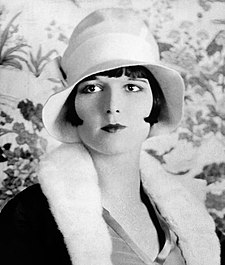Louise Brooks
| Louise Brooks | |
|---|---|

(c.1926)
|
|
| Born |
Mary Louise Brooks November 14, 1906 Cherryvale, Kansas, U.S. |
| Died | August 8, 1985 (aged 78) Rochester, New York, U.S. |
| Cause of death | Heart attack |
| Resting place | Holy Sepulchre Cemetery |
| Nationality | American |
| Other names | Lulu |
| Occupation | Actress, dancer |
| Years active | 1925–1938 |
| Spouse(s) |
A. Edward Sutherland (m. 1926–28) Deering Davis (m. 1933–38) |
Mary Louise Brooks (November 14, 1906 – August 8, 1985), who worked professionally as Louise Brooks, was an American film actress and dancer noted as an iconic symbol of the flapper, and for popularizing the bobbed haircut.
Brooks is best known as the lead in three feature films made in Europe: Pandora's Box (1929), Diary of a Lost Girl (1929), and Miss Europe (1930); the first two were made by G. W. Pabst. She starred in seventeen silent films and eight sound films before retiring in 1938. Brooks published her memoir, Lulu in Hollywood, in 1982; three years later she died of a heart attack at the age of 78.
Born in Cherryvale, Kansas, Louise Brooks was the daughter of Leonard Porter Brooks, a lawyer, who was usually too busy with his practice to discipline his children, and Myra Rude, an artistic mother who determined that any "squalling brats she produced could take care of themselves".
Rude was a talented pianist who played the latest Debussy and Ravel for her children, inspiring them with a love of books and music.
When she was nine years old, a neighborhood predator sexually abused Louise. This event had a major influence on Brooks' life and career, causing her to say in later years that she was incapable of real love, and that this man "must have had a great deal to do with forming my attitude toward sexual pleasure....For me, nice, soft, easy men were never enough – there had to be an element of domination". When Brooks at last told her mother of the incident, many years later, her mother suggested that it must have been Louise's fault for "leading him on".
Brooks began her entertainment career as a dancer, joining the Denishawn modern dance company in Los Angeles (whose members included founders Ruth St. Denis, and Ted Shawn, as well as a young Martha Graham) in 1922. In her second season with the company, Brooks had advanced to a starring role in one work opposite Shawn. A long-simmering personal conflict between Brooks and St. Denis boiled over one day, however, and St. Denis abruptly fired Brooks from the troupe in 1924, telling her in front of the other members that "I am dismissing you from the company because you want life handed to you on a silver salver". The words left a strong impression on Brooks; when she drew up an outline for a planned autobiographical novel in 1949, "The Silver Salver" was the title she gave to the tenth and final chapter.
...
Wikipedia
